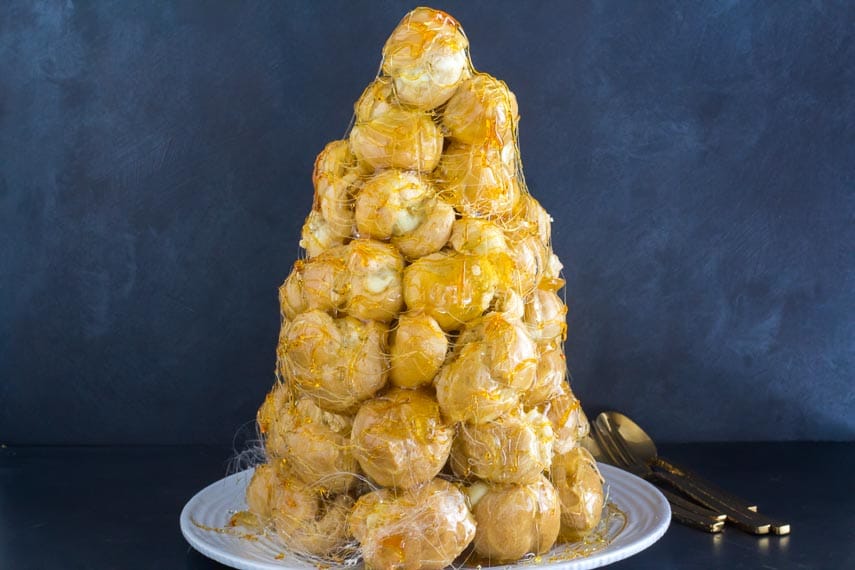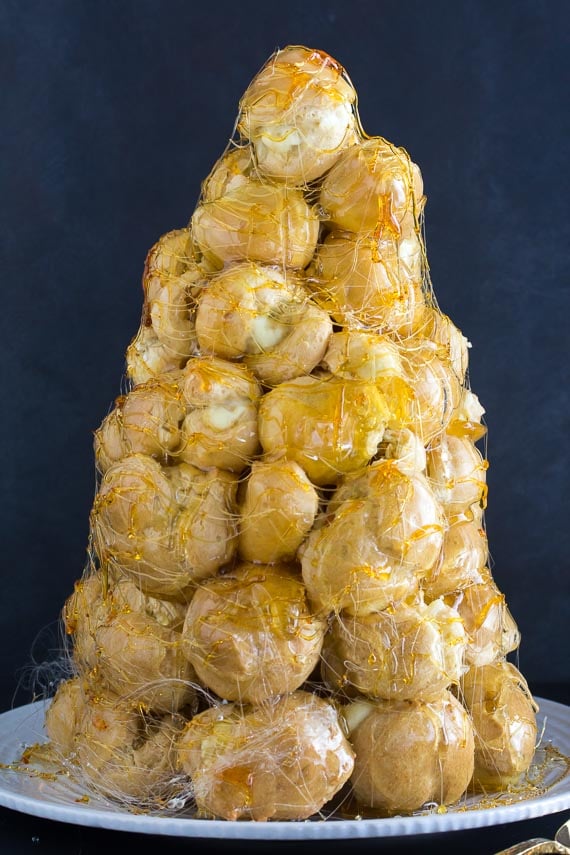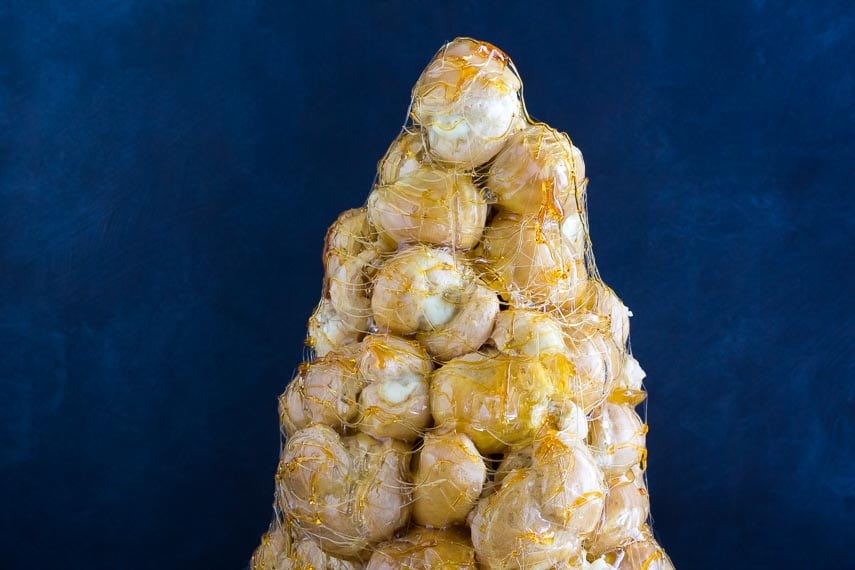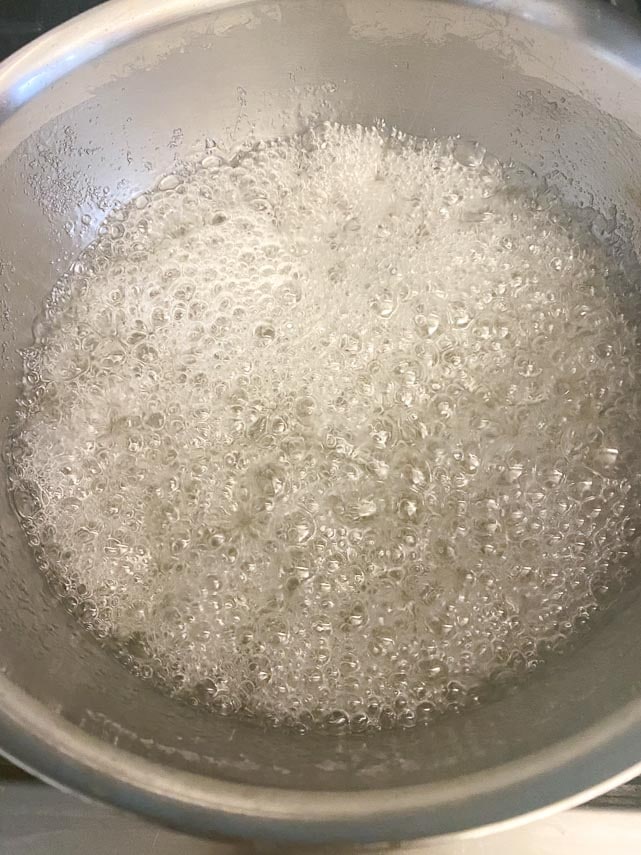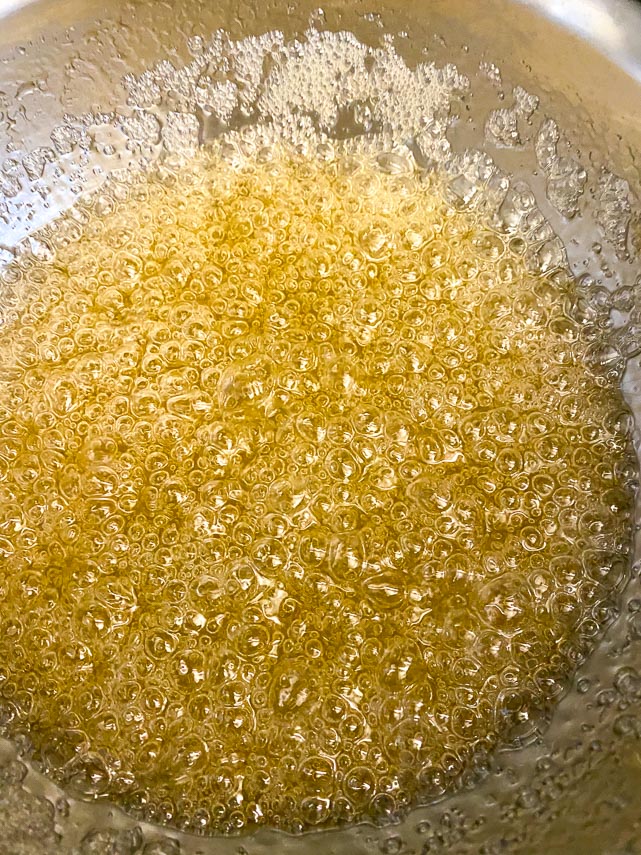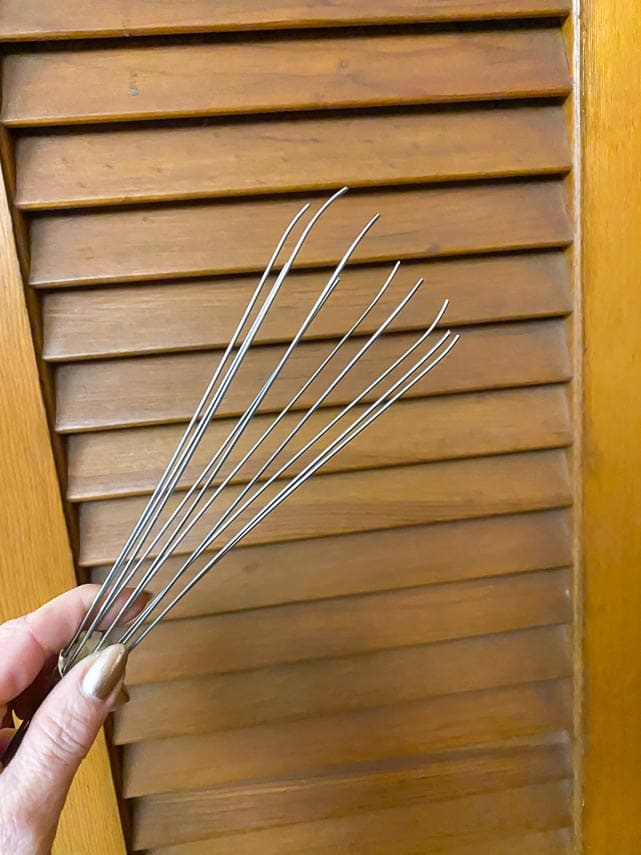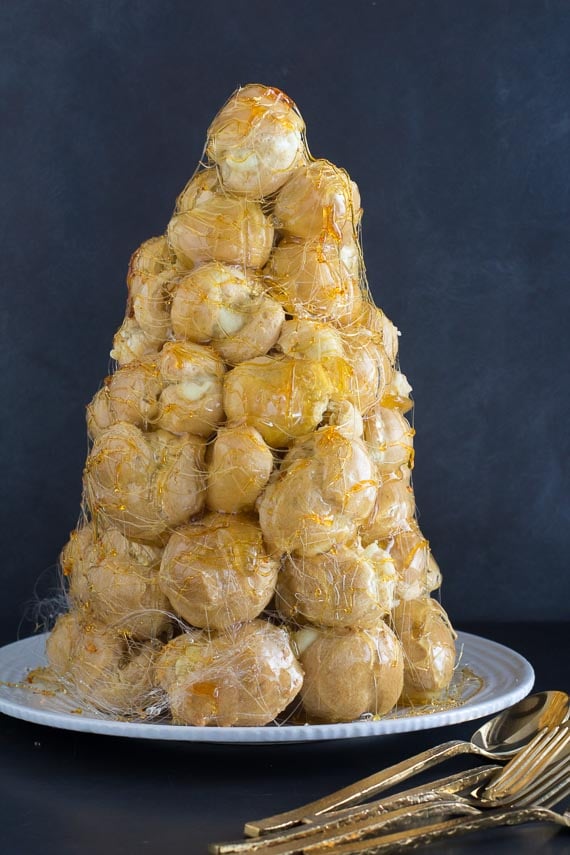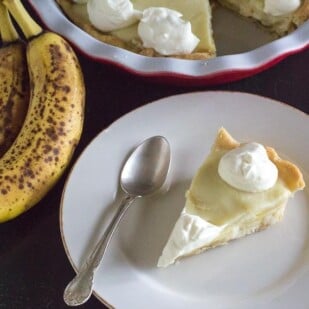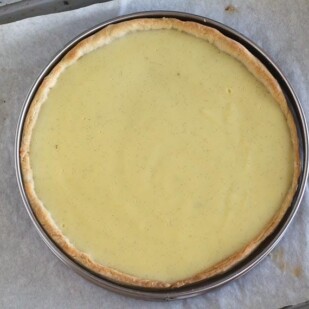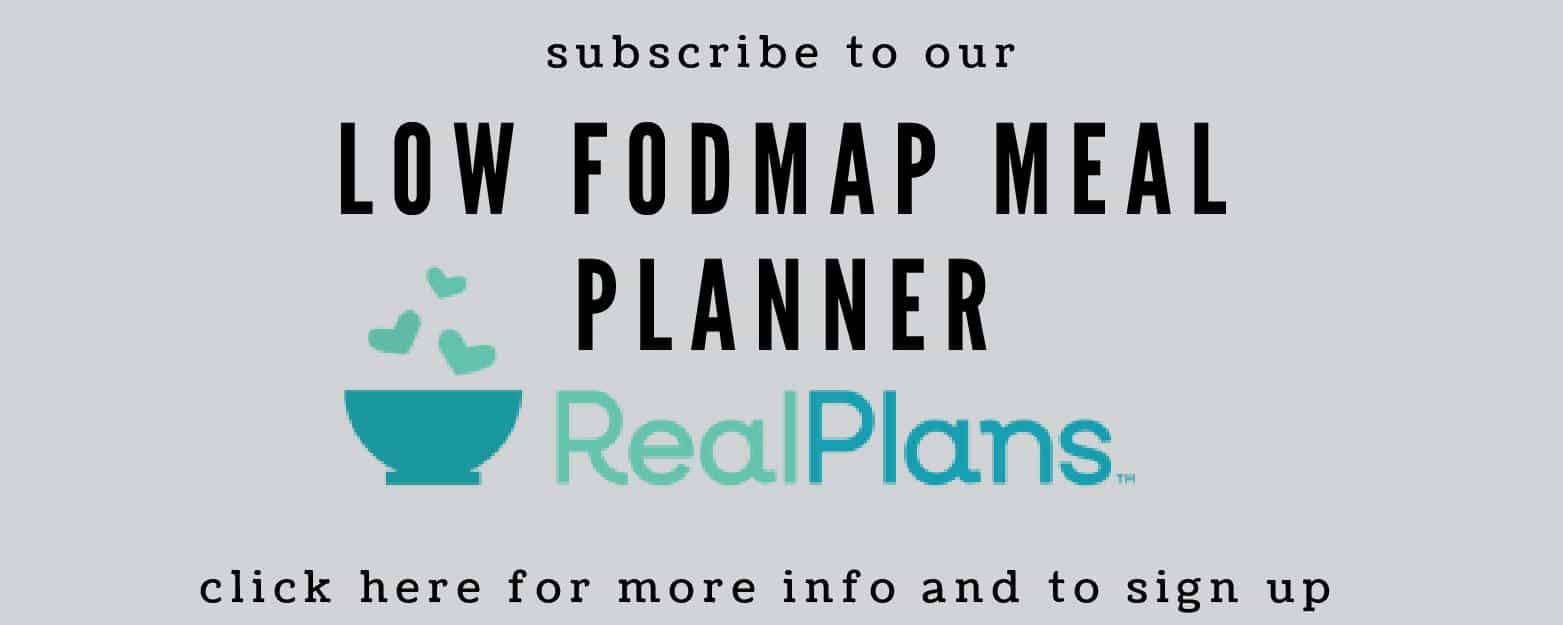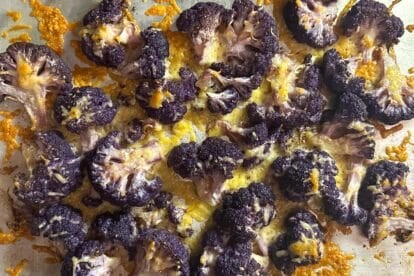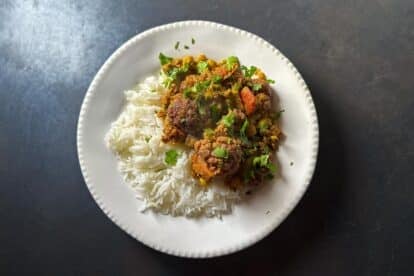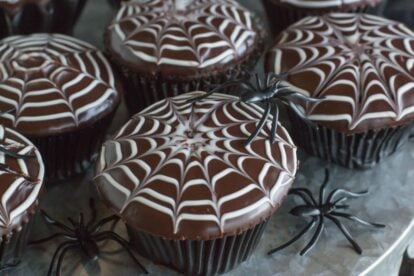Our Low FODMAP Croquembouche, a tower of gluten-free cream puffs, filled with lactose-free pastry cream, is assembled using hard, glistening caramel. This is a showstopper low FODMAP dessert for special occasions best attempted by experienced bakers.
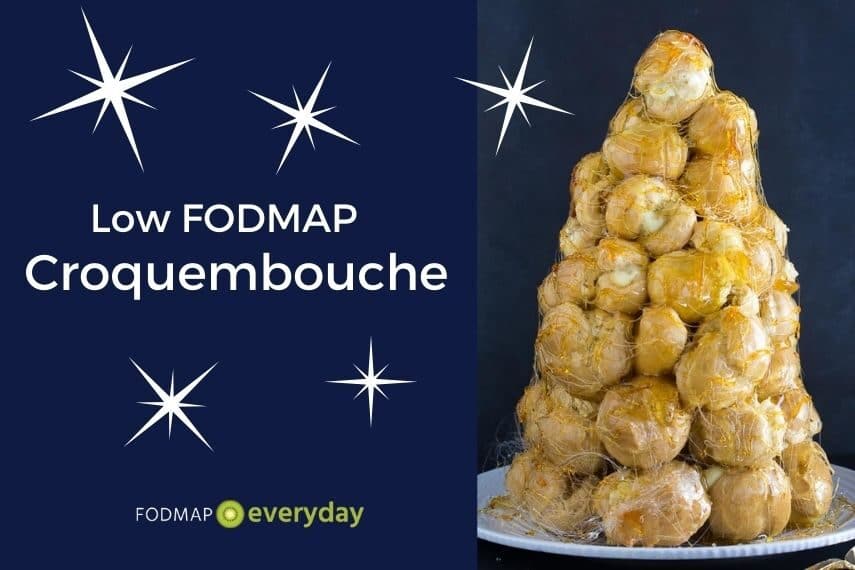
What Is Croquembouche?
Croquembouche is a traditional French dessert. It is a cone-shaped tower of cream puffs, held together with caramel, sometimes additionally decorated by spun sugar, sugared almonds, gum paste or marzipan flowers or other decor. Particularly elaborate versions might be mounted on a nougatine base. In France this kind of large dramatic treat is often referred to as a “piece montée”, which references the fact that they are architectural in design. Croquembouche are often served at weddings and other important celebrations
How Do You Pronounce Croquembouche?
Say, krow-kuhm-boosh.
What Does Croquembouche Mean?
“Croque” is a French word meaning to crunch or bite into, and “bouche” means mouth. Put together it is crunch-in-the-mouth, which refers to the fact that the cream puffs that make up a croquembouche are dipped in hard, crunchy caramel – they do indeed crunch in the mouth, delightfully.
How Do You Serve Croquembouche?
Croquembouche is not easy to serve. The best way is to use two forks to gently pry off two puffs at a time. This is one serving. The puffs are glued together with the caramel and they usually do not pull off in nice little round shapes. They might look a little worse for the wear, but I have never had anyone complain because they taste absolutely delicious. Although it is not necessary or traditional, I like to serve these with a little thinned Chocolate Ganache spooned first onto the plate. Just use more cream than is called for to make a flowable sauce. Totally optional but delicious.
What Can I Make Ahead?
This dessert is a project. It is best for seasoned bakers; that said, there are ways to make it easier by taking advantage of do-ahead components.
Our croquembouche is made up of Cream Puffs, Pastry Cream & Caramel, and optional chocolate sauce.
- Pâte à Choux Cream Puffs – These can be made even 1 month ahead and frozen. Or make them and hold at room temperature for 24 hours.
- Pastry Cream – Pastry Cream can be made up to 3 days ahead.
- Caramel – This component has to be made right before using.
- Chocolate Sauce – Use our Chocolate Ganache recipe but make it a bit thinner than is directed to make a flowy sauce. It can be refrigerated up to a week ahead or frozen for 1 month. Reheat when ready to use. Optional, a but really spectacular yet easy addition.
Can I Make The Pâte à Choux All At Once?
Making the pâte à choux all at once doesn’t make sense for a few reasons. First of all, if you are using a mixer, some will not accommodate more dough (it is heavy and sticky). If you are making it by hand, you would need an enormous amount of elbow grease to make a larger batch. And finally, how many racks do you have in your oven? How many pans do you have? Even if you made the pâte à choux all at once, you might not be able to accommodate baking it.
Can I Make The Pastry Cream All At Once?
If you have a large, heavy bottom pot, are an experienced pastry cream maker, and understand how to keep the eggs from scrambling, then go for it. Personally, I think this is a dicey proposition.
Can I Make The Caramel All At Once?
You have to make the caramel twice. Do not attempt to make double the recipe all at once as the caramel will cool too quickly for you to use as you embark upon assembly.
Can I Make A Smaller Croquembouche?
You can, but believe me when I say that if you are going to make the effort, then why not pull out all the stops. The serving size is geared towards FODMAPers. Others will want a larger serving.
How To Make Croquembouche
Filling The Cream Puffs
Have all components ready. The pâte à choux puffs should be defrosted and/or already at room temperature. The pastry cream should be chilled and firm. Fit your pastry bag with the plain tip and fill the bag with the pastry cream. Insert the tip into each puff and fill with the pastry cream and place filled puffs back on a rimmed sheet pan to hold them.
Making The Caramel & Assembly
The caramel will be what holds your creation together. The sweet cement, as it were. This should be made immediately before assembly of croquembouche.
Have a pretty, strong, flat platter handy that is at 10-inch (25 cm) in diameter. You will be assembling the croquembouche from the bottom up, beginning with a ring of puffs about 8-inches(20 cm) in diameter. Take a good look at your platter now and visualize what that ring will look like and where you will place your first caramel-dipped puff – about 2-inches (5 cm) in from the edge of the platter.
Set up your workplace as follows (if you want to get fancy, call it a mise en place, like chef’s do). Have the tray of filled puffs to your left, your pot of caramel (that you are about to make) will be in the middle, then have your display platter on the right.
Prepare First Batch Of Caramel
Make your first batch of caramel. Fill a large bowl with ice water; set aside. Place sugar, water and corn syrup in a medium saucepan and stir to combine. Heat over medium heat bringing to a boil. If you want to be really fancy and authentic, use a French Copper sugar pot – but of course you don’t have to.
Brush down sides with a damp pastry brush and swirling pan occasionally (do not stir), and cook until caramel begins to take on color. Do not walk away!
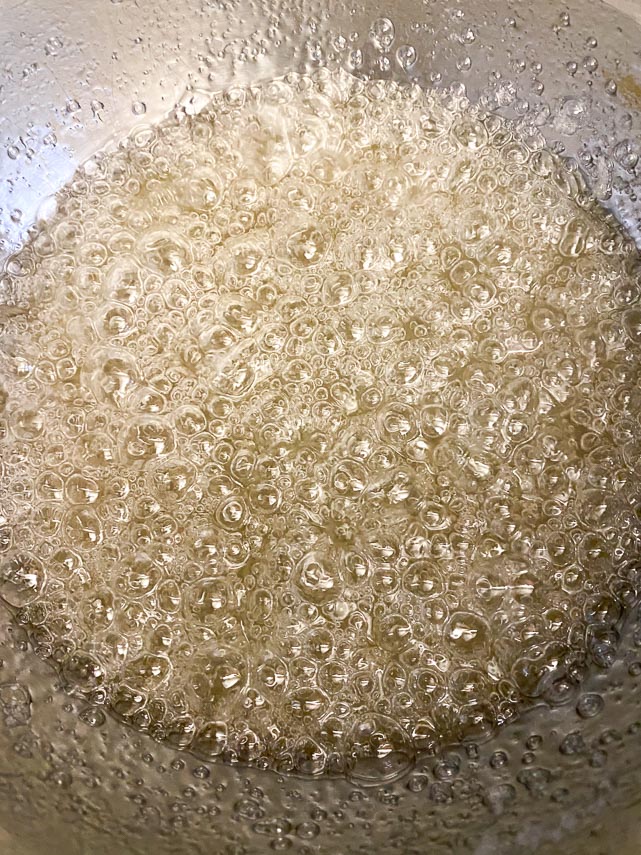
Keep cooking until it turns a might amber color as seen below:
Set bottom of saucepan in ice water to stop the cooking and to firm the caramel slightly. Place your pot of caramel in its spot in your workflow.
Start with the larger puffs for the initial rings. One by one dip a cream puff into the caramel, allowing excess to drip back into the caramel pot and immediately place on platter. Take care as the caramel is very hot and can burn you quite easily. Place that first puff 2-inches (5 cm) from the edge. Place the second puff right next to it, touching. Keep going until you have a ring of attached cream puffs, with the caramel acting as glue.
Your second ring will be slightly smaller. Keep going up with subsequent rings. Every croquembouche takes on its own subtle shape. Keep assessing it as you go, placing larger or smaller puffs where needed to keep the tower as symmetrical as possible. Sometimes you do need to place some inside the ring for support. That’s okay! Go for it. You are playing sugar architect.
Re-warm As Needed
You will most likely have to re-warm the caramel a few times as you work; keep it fluid but try not to not cook it and darken it any more than it already is. And at some point, you will need to make your second batch of caramel.
When your tower is done you can dip a fork in the caramel and make casual spins of caramel around the whole creation for extra oomph. Some pastry chefs snip the top off of a balloon whisk specifically to use for this purpose and for making spun sugar.
If the caramel is too thick, simply reheat. If it is too hot, it will be too thin to make the strands. Manipulate the temperature as needed.
Serving Your Croquembouche
The finished croquembouche can sit for a few hours at cool room temperature. To serve, have optional chocolate sauce ready to go and use two forks to pry the cream puffs away from the tower. They won’t look very neat on the plate, but no one ever minds. Aim for about 2 puffs per low FODMAP serving. Others can have more!
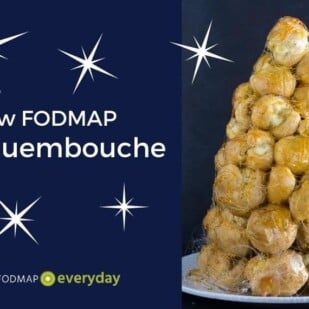
Low FODMAP Croquembouche
Our Low FODMAP Croquembouche, a tower of gluten-free cream puffs, filled with lactose-free pastry cream, is assembled using hard, glistening caramel. This is a showstopper low FODMAP dessert for special occasions. This recipe is best for experienced bakers.
Low FODMAP Serving Size Info: This makes a towering creation. Aim for 2 pufs per low FODMAP person. Others can have more. There will be approximately 55 cream puffs.
Ingredients:
- 4 batches Low FODMAP Pâte à Choux, formed into small cream puffs, baked and cooled
- 3 batches Low FODMAP Pastry Cream, chilled and firm
- Pastry bag and round tip such as Ateco #802 or Wilton #12
Caramel (2 x):
- 2 ½ cups (495 g) sugar
- 1/2 cup (120 ml) water
- 2 tablespoons light corn syrup
Preparation:
-
Filling Cream Puffs: Have all components ready. The pâte à choux puffs should be defrosted and/or already at room temperature. The pastry cream should be chilled and firm. Fit your pastry bag with the plain tip and fill the bag with the pastry cream. Insert the tip into each puff and fill with the pastry cream and place filled puffs back on a rimmed sheet pan to hold them.
-
Caramel & Assembly: Have a pretty, strong, flat platter handy that is at 10-inch (25 cm) in diameter. You will be assembling the croquembouche from the bottom up, beginning with a ring of puffs about 8-inches(20 cm) in diameter. Take a good look at your platter now and visualize what that ring will look like and where you will place your first caramel-dipped puff – about 2-inches (5 cm) in from the edge of the platter.
-
Set up your workplace as follows (if you want to get fancy, call it a mise en place, like chef’s do). Have the tray of filled puffs to your left, your pot of caramel will be in the middle, then have your display platter on the right.
-
Make your first batch of caramel. Fill a large bowl with ice water; set aside. Place sugar, water and corn syrup in a medium saucepan and stir to combine. Heat over medium heat bringing to a boil, brushing down sides with a damp pastry brush and swirling pan occasionally (do not stir), and cook until caramel turns a light amber color. Set bottom of saucepan in ice water to stop the cooking and to firm the caramel slightly. Place your pot of caramel in its spot in your workflow.
-
Start with the larger puffs for the initial rings. One by one dip a cream puff into the caramel, allowing excess to drip back into the caramel pot and immediately place on platter. Take care as the caramel is very hot and can burn you quite easily. Place that first puff 2-inches (5 cm) from the edge. Place the second puff right next to it, touching. Keep going until you have a ring of attached cream puffs, with the caramel acting as glue.
-
Your second ring will be slightly smaller. Keep going up with subsequent rings until you make a cylindrical tower. Every croquembouche takes on its own subtle shape. Keep assessing it as you go, placing larger or smaller puffs where needed to keep the tower as symmetrical as possible. Sometimes you do need to place some inside the ring for support. That’s okay! Go for it. You are playing sugar architect.
-
You will most likely have to re-warm the caramel a few times as you work; keep it fluid but try not to not cook it and darken it any more than it already is. And at some point, you will need to make your second batch of caramel.
-
When your tower is done you can dip a fork in the caramel and make casual spins of caramel around the whole creation for extra oomph. If it is too thick, simply reheat. If it is too hot, it will be too thin to make the strands. Manipulate the temperature as needed.
-
The finished croquembouche can sit for a few hours at cool room temperature. To serve, have optional chocolate sauce ready to go and use two forks to pry the cream puffs away from the tower. They won’t look very neat on the plate, but no one ever minds.
Notes:
Tips
FODMAP Information
Our recipes are based on Monash University and FODMAP Friendly science.
- Butter: Both Monash University and FODMAP Friendly have lab tested butter. Monash states that a low FODMAP Green Light portion is 1 tablespoon or 19 g and also states that “butter is high in fat and does not contain carbohydrates (FODMAPs)”. FODMAP Friendly gives it a “Pass” at 1 tablespoon or 19 g. Both recommended serving sizes are presented as part of healthy eating guidelines, not as maximum FODMAP serving size. Fat can affect guy motility and trigger IBS symptoms in some people. Eat to your tolerance.
- Eggs: Eggs are high in protein and do not contain carbohydrates, according to Monash University.
- Sugar: Monash University and FODMAP Friendly have both lab tested white, granulated sugar. Monash states that a Green Light low FODMAP serving size of white sugar is ¼ cup (50 g). FODMAP Friendly simply states that they have tested 1 tablespoon and that it is low FODMAP. Regular granulated white sugar is sucrose, which is a disaccharide made up of equal parts glucose and fructose. Sucrose is broken down and absorbed efficiently in the small intestine.
Please always refer to the Monash University & FODMAP Friendly smartphone apps for the most up-to-date lab tested information. As always, your tolerance is what counts; please eat accordingly. The ultimate goal of the low FODMAP diet is to eat as broadly as possible, without triggering symptoms, for the healthiest microbiome.
Nutrition
All nutritional information is based on third-party calculations and should be considered estimates. Actual nutritional content will vary with brands used, measuring methods, portion sizes and more. For a more detailed explanation, please read our article Understanding The Nutrition Panel Within Our Recipes.

